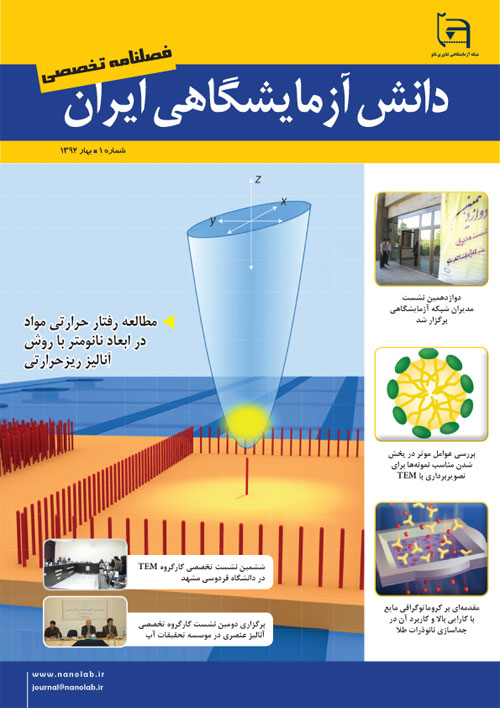فهرست مطالب

مجله دانش آزمایشگاهی ایران
پیاپی 1 (بهار 1392)
- 50 صفحه،
- تاریخ انتشار: 1392/03/20
- تعداد عناوین: 8
-
صفحه 3
- اخبار
-
اخبار / دوازدهمین نشست مدیران شبکه آزمایشگاهی برگزار شد/ ششمین نشست تخصصی کارگروه TEM در دانشگاه فردوسی مشهد/ برگزاری اولین نمایشگاه تجهیزات و مواد آزمایشگاهی ساخت ایرانصفحه 4
- گزارش
- مقالات
-
صفحه 45
-
Page 10
The present research investigates the governance structure of seven science and technology (S&T) collaborative networks founded from 1995 to 2005 in I. R. of Iran. Conducting a qualitative inquiry and using multiple-case study method, researcher has collected related data adequately from semi-structured interviews with key informants, observation, and archived documents. In this article, several types of governance structures and key actors of S&T networks as well as roles of the actors are described and classified. We used the content analysis method and cross-case analysis technique to derive some implications from the processed data. The paper concludes that S&T networks in Iran, have utilized two main types of governance structure namely: participative and hierarchical. The hierarchical structure enhances the power of the network director but decrease the social capital of the network, while the participative structure leads to the reverse results. The study shows that a number of factors affect the type of network’s structure such as; network’s main financial sponsor and the positions of network’s founding organization in contrast with network’s members.
Keywords: collaborative networks, Multiple-caseStudy, S&T networks -
Page 21
Micro-thermal analysis combines the imaging capabilities of atomic force microscopy (with the ability to characterize with high spatial resolution) and one of the thermal analysis methods. In this method, a thermal probe has replaced with SPM tip. The probe can be heated by passing a current through it and the power required to maintain the tip at a constant temperature can be monitored during sample surface scanning. This used to build up thermal and topographic images, simultaneously. Areas of interest may then be selected and thermal changes in nano scale can be detected by localized thermal analysis. Chemical analysis of evolved gases is then also possible by coupling the system with analyzer ones such as GC-MS or MS.
Keywords: Microthermal analysis, Scanningthermal microscopy, thermal analysis, Atomic Force Microscopy, Themalprobe -
Page 30
Dispersion is one of the most popular techniques to powder sample preparation for TEM imaging. Powder dissolved in a relatively volatile solvent will be dropped on a circular copper grid. If the sample is not already dispersed in solution, it will be agglomerated and formed into large particles which are not proper to TEM imaging. In this study the effects of different parameters such as temperature, pH, Ultrasonic, etc. on dispersion of particles have been investigated. It shows that the increase in ultrasonic's time cause to the better dispersion but it has an optimum time. Using surfactants depends on the other parameters and it will be easily operable by measuring Zeta potential.
Keywords: TEM, dispersion, Sample prepration -
Page 37
High Performance Liquid Chromatography (HPLC) is one of the most used chromatography techniques. Chromatography process can be defined as separation technique involving mass-transfer between stationary and mobile phase. HPLC utilizes a liquid mobile phase to separate the components from a mixture. The stationary phase can be a liquid or a solid phase. HPLC acquires a high degree of versatility not found in other chromatographic systems and it has the ability to easily separate a wide variety of chemical mixtures. Depending on the HPLC mode, the different types of the adsorption forces may be included in the retention process: Hydrophobic (non-specific) interactions are the main ones in reversed-phase (RP) separations. Dipole-dipole (polar) interactions are dominant in normal phase (NP) mode. Ionic interactions are responsible for the retention in ion-exchange chromatography. SEC (size-exclusion chromatography) is another case. It is the separation of the mixture by the molecular size of its components. HPLC instrumentation includes a pump, injector, column, detector and data system. The heart of the system is the column where separation occurs. Nanometer-sized metal materials have attracted extensive attention in the fields of physics, chemistry, and biology. Transmission electron microscopy (TEM) is generally employed to characterize the size and shape of metal clusters to understand the correlation between particle size and physicochemical properties. However, TEM is a timeconsuming technique and does not involve any separating process. Since size depending optical spectra of nanoparticles can be easily obtained by chromatographic systems with diode array detection (DAD). Hence, chromatographic methods can be utilized in helping the characterization of size-dependent properties of metal nanoparticles. Size exclusion chromatography (SEC) has been employed and combined with TEM to characterize nanometer-sized gold particles ranging in size of 3 to 20 nm successfully.
Keywords: Gold nanoparticlesLiquid Chromatography


